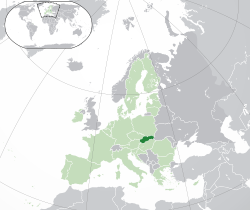
Slovakia
Country in Central Europe / From Wikipedia, the free encyclopedia
Dear Wikiwand AI, let's keep it short by simply answering these key questions:
Can you list the top facts and stats about Slovakia?
Summarize this article for a 10 years old
Slovakia (/sloʊˈvækiə, -ˈvɑːk-/ ⓘ;[8][9] Slovak: Slovensko [ˈslɔʋenskɔ] ⓘ), officially the Slovak Republic (Slovak: Slovenská republika [ˈslɔʋenskaː ˈrepublika] ⓘ), is a landlocked country in Central Europe. It is bordered by Poland to the north, Ukraine to the east, Hungary to the south, Austria to the west, and the Czech Republic to the northwest. Slovakia's mostly mountainous territory spans about 49,000 square kilometres (19,000 sq mi), with a population of over 5.4 million. The capital and largest city is Bratislava, while the second largest city is Košice.
Slovak Republic | |
|---|---|
| Anthem: Nad Tatrou sa blýska (Slovak) (English: "Lightning over the Tatras") | |
| National seal | |
 Location of Slovakia (dark green) – in Europe (green & dark grey) | |
| Capital and largest city | Bratislava 48°09′N 17°07′E |
| Official languages | Slovak |
| Ethnic groups (2021)[1] |
|
| Religion (2021)[2] |
|
| Demonym(s) | Slovak |
| Government | Unitary parliamentary republic |
| Zuzana Čaputová | |
| Ľudovít Ódor | |
| Boris Kollár | |
| Legislature | National Council |
| Establishment history | |
| 28 October 1918 | |
| 30 September 1938 | |
• Autonomous Land of Slovakia (within Second Czechoslovak Republic) | 23 November 1938 |
| 14 March 1939 | |
| 24 October 1945 | |
| 1948 | |
| 11 July 1960 | |
• Slovak Socialist Republic (within Czechoslovak Socialist Republic, change of unitary Czechoslovak state into a federation) | 1 January 1969 |
| 1 March 1990 | |
| 1 January 1993 | |
| Area | |
• Total | 49,035 km2 (18,933 sq mi) (127th) |
• Water (%) | 0.72 (2015)[3] |
| Population | |
• 2022 census | |
• Density | 111/km2 (287.5/sq mi) (88th) |
| GDP (PPP) | 2023 estimate |
• Total | |
• Per capita | |
| GDP (nominal) | 2023 estimate |
• Total | |
• Per capita | |
| Gini (2019) | low |
| HDI (2021) | very high · 45th |
| Currency | Euro (€) (EUR) |
| Time zone | UTC+1 (CET) |
| UTC+2 (CEST) | |
| Date format | d. m. yyyy |
| Driving side | right |
| Calling code | +421 |
| ISO 3166 code | SK |
| Internet TLD | .sk and .eu |
The Slavs arrived in the territory of the present-day Slovakia in the fifth and sixth centuries. In the seventh century, they played a significant role in the creation of Samo's Empire. In the ninth century, they established the Principality of Nitra, which was later conquered by the Principality of Moravia to establish Great Moravia. In the 10th century, after the dissolution of Great Moravia, the territory was integrated into the Principality of Hungary, which then became the Kingdom of Hungary in 1000.[10] In 1241 and 1242, after the Mongol invasion of Europe, much of the territory was destroyed. The area was recovered largely thanks to Béla IV, who also settled Germans, leading them to become an important ethnic group in the area, especially in what are today parts of central and eastern Slovakia.[11]
After World War I and the dissolution of Austria-Hungary, the state of Czechoslovakia was established. In the lead up to World War II, local fascist parties gradually came to power in the Slovak lands, and the first Slovak Republic was established as a client state of Nazi Germany. The Slovak Republic heavily persecuted the local Jewish population, eventually murdering or deporting almost 70,000 Jews. Internal opposition to the fascist government's policies culminated in the Slovak National Uprising, itself triggered by the Nazi German occupation of the country. Although the uprising was eventually suppressed, partisan resistance continued, and Czechoslovak independence was re-established after the country's liberation at the end of the war. After a short period of multi-party democracy, Czechoslovakia became a communist state after a 1948 coup, and became part of the Soviet-led Eastern Bloc. Attempts to liberalise communism culminated in the Prague Spring, which was suppressed by the Warsaw Pact invasion of Czechoslovakia in August 1968. In 1989, the Velvet Revolution peacefully ended Communist rule in Czechoslovakia. Slovakia became an independent state on 1 January 1993 after the peaceful dissolution of Czechoslovakia, sometimes known as the Velvet Divorce.
Slovakia is a developed country with an advanced high-income economy. The country maintains a combination of a market economy with a comprehensive social security system, providing citizens with universal health care, free education, and one of the longest paid parental leaves in the OECD.[12] Slovakia is a member of the European Union, the Eurozone, the Schengen Area, the United Nations, NATO, CERN, the OECD, the WTO, the Council of Europe, the Visegrád Group, and the OSCE. Slovakia is also home to eight UNESCO World Heritage Sites. The world's largest per-capita car producer, Slovakia manufactured a total of 1.1 million cars in 2019, representing 43% of its total industrial output.[13]


